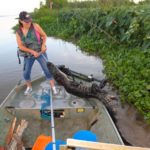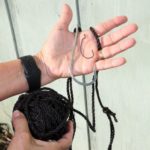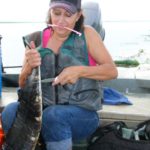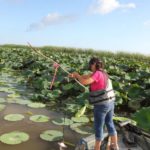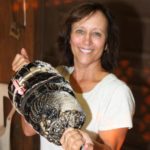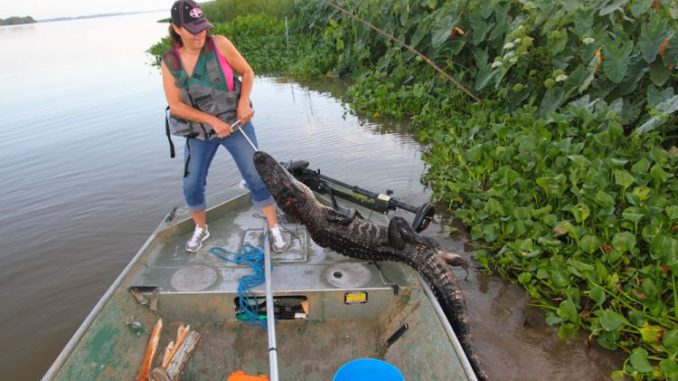
Each year, the general public has the opportunity to participate in Louisiana’s annual alligator harvest. Here’s what you need to know if your name gets pulled.
It’s a long boat ride down the Calumet spillway to the Atchafalaya Delta Wildlife Management Area’s Wax Lake Unit. It’s also a straight run, which makes it a perfect time for reflecting. In other words, once you push your throttle forward and get your boat heading south, for the next 30 minutes or so you have time to go over mental checklists or anything else that comes to mind.
With my wife Christine sitting next to me, my thoughts drifted to how excited she was following the mandatory training session at the Louisiana Department of Wildlife and Fisheries office in New Iberia, when she received her three alligator tags.
I had put both of us in for the Lottery Alligator Harvest Program, hoping at least one of us would draw out for the Atchafalaya Delta WMA, which is close to our home in St. Mary Parish.
But she was the lucky one who got pulled for the gator tags that are made available annually to the general public. In fact, out of the 10 lucky winners at the Delta, four happened to be ladies.
The commercial harvest of alligators is at the core of Louisiana’s philosophy when it comes to managing this highly sought-after and very visible resource. Nonetheless, the LDWF continues to look for more and more opportunities for the general public.
In 2015, the department made 897 tags available on 45 public lakes and WMAs for 349 hunters. It was pretty much the same in 2016. Then in 2017, that number grew to 937 tags made available to 363 recreational gator hunters.
“There was a misconception that the general public didn’t really have the opportunity to hunt alligators,” said Ed Mouton, LDWF’s alligator program manager. “However, I think the lottery program continues to be really successful and has expanded, particularly since 2008 when nine WMAs were added to our public lakes program. There are still some people that don’t realize alligator hunting is available to them.
“But, between our coastal WMAs, upland WMAs and public lakes, it provides quite a bit of opportunity for people to have the experience of harvesting an alligator.”
Rules and regs
Louisiana alligator hunting regulations limit lottery hunters to just six lines for the three tags they are issued. And lines on the WMAs have to be marked with the hunter’s name, so in the event hunters are struggling or doing something incorrectly, technicians and biologists out on the refuge can assist by contacting them directly.
Since I had previously been a licensed commercial alligator hunter for 25 years, it was easy for me to purchase the required helper’s license and give aid to my bride anyway I could. However, she insisted on doing as much as her 5-foot, 2-inch, 125-pound frame would allow. Lots of that included driving stobs in the marsh to secure lines, setting poles to suspend the hooks, stringing lines from stob to pole and finally baiting them.
All that happened before running the lines the following morning — and she would have to retrieve and dispatch the animals herself.
“Some people think that it’s very easy. They watch shows on TV like Swamp People and others and think, ‘It’s a piece of cake. I can do that,’” Mouton said. “Then they go out and experience trying to set lines, and deal with knocked-down or pulled lines. Just the habitat itself and navigating the waterways is difficult. “They soon realize it’s no easy task to harvest an alligator.”
Terrain varies throughout the state, and what lottery hunters will notice right away on the Atchafalaya Delta WMA is it’s a vast open marsh, with a hard sand bottom and a noticeable lack of trees where you could attach a line.
In short, you’re not shoving a stob down into the sand by hand to secure a line. Therefore, it’s imperative you bring a sledgehammer to drive a 5 ½- to 6-foot-long stob deep enough to hold a big gator. (That was about the only task I performed for Christine.)
The LDWF requires first-time alligator hunters to go through mandatory training, and obviously, using the correct line and hook is vitally important.
Jeb Linscombe, a biologist manager for the alligator program, told me how technicians were able to save two first-time lottery hunters’ seasons: One was trying to catch gators on a 4/0 bass hook, and the other was using insufficient line that kept breaking.
“We have a video that shows the whole process,” Linscombe said. “Before we allow people to go out there, we want to make sure they know what they’re doing.”
Gearing up
Alligator hunters should use at least 12/0 hooks, and no less than No. 6, 3/16-inch diameter 900-pound tarred nylon seine twine. Length of line varies by a hunter’s personal preference, but no less than 35 feet should be used in most applications. Personally, I use 50 feet.
There are baits galore that have been tried by both commercial and sport hunters over the years. But, perhaps nothing works better than chicken thighs with the drumstick still attached. Alligators patrol their territory at night, and not only does the whitish/yellow skin of chicken flesh stand out, but the oily meat’s odor gets stronger as it spoils — a combination that makes for deadly bait.
For the record, alligator hunters also have used nutria quarters, but they tend to dry out like jerky. Beef melt has been used, along with pogies and mullet. But, it’s rotten chicken that has landed more alligators than any other bait.
Having the right tools for the job also is important, and G&B Gator Gear is in the business of equipping alligator hunters.
Over the internet, G&B sells everything associated with gator catching. As the apex predator of fresh and brackish water marshes and swamps in the Deep South, nine states will hold some sort of commercial or recreational season in 2018.
“Our sales have really taken off the past few years as the popularity of hunting alligators is on the increase — mainly because of television,” said Bill George, G&B’s owner. “We sell a lot of gear in both Louisiana and Mississippi.”
Details of the hunt
Eventually, we arrived at Christine’s first set. Approaching it slowly, we could see the bait was taken. I shut off the engine and raised it out of the water so the line wouldn’t become entangled in the prop or even worse, cut.
The line stretched from the stob on the bank out 50 feet into the deeper waters of Greg Pass, where we had placed the sets on the refuge. My wife lifted the line ever so gently, and feeling a couple of small jerks and a gentle tug, her eyes got big.
“Bring it up really slow and keep the excess line off the bow of the boat,” I said, coaching her through the process. At 58, this Cajun girl was about to harvest her first-ever alligator.
The water was stained — a perfect scenario because a played-out gator more often than not will come up from the depths with ease. But when the water is clear and they see you, the whole process can become chaotic if they’re spooked.
When she saw the gator’s shadow approximately 2 feet below the surface, I readied the .22 rifle and handed it over to her. Gingerly lifting the alligator to the point where its head just broke the surface of the water, she humanely dispatched the animal with a well-placed shot. That gator measured 7 feet, 9 inches — a good one.
Her next two lines held two more 7-footers. At that point her tags were filled, and whatever was on her last three lines would have to be released. As it turned out, she had two more gators hooked up, both in the 6-foot range.
Where to go
When it comes to success, all of Louisiana’s coastal WMAs are good, and most successful lottery applicants tag out. For sheer size, though, head to the backwater swamps and sloughs of some of North Louisiana’s public lakes.
In 2015, Christina Rivers drew out for two of 16 lottery tags available on Toledo Bend. She and her father Roger tagged a pair of 14-foot, 1-inch matching alligators on the north end of the lake.
Besides the non-refundable $5 application fee to participate in the lottery, there is also a $40 non-refundable tag fee and a $25 resident alligator hunting license to obtain.
Post-harvest options
Licensed hunters should decide what they plan to do with their alligators after harvest. The meat is delicious when properly cleaned and processed. But, if you opt to skin your alligators, keep the meat and ultimately sell the hides, all skins are required to be inspected by the LDWF prior to sale.
Though there has been some improvement the past few years, alligator prices haven’t fully recovered from what they were prior to the economic downturn of 2008. Hunters may also opt to have their hides tanned to utilize the leather for personal items.
The LDWF provides all necessary contact details for hunters following the training session. Two tanneries available are American Tannery & Leather, which purchases alligators in Breaux Bridge during the season, or Reptile Tannery in Lafayette.
Concerning the wild alligator harvest, Linscombe said, “The harvest may be down this year due to prices, but we really don’t know until the season gets underway because things can change. We’ll just have to wait and see.”
We skinned Christine’s alligators and kept some of the meat, then took the hides in for processing. With five available coastal WMAs, 15 upland WMAs and 25 public lakes, never has there been more opportunity for the public to obtain alligator harvest tags. All you have to do is apply — and then cross your fingers.
How to apply
Louisiana has a systematic lottery application process. Typically around June or July, the Louisiana Wildlife Commission sets dates for the upcoming alligator season. Afterwards, the LDWF will make alligator lottery announcements and those interested in participating can go to www.wlf.louisiana.gov to download an application.
